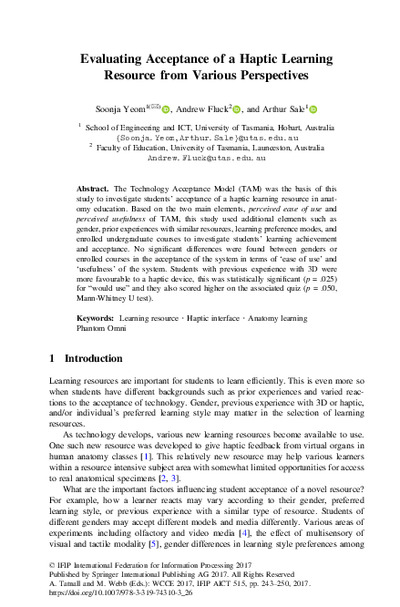Evaluating Acceptance of a Haptic Learning Resource from Various Perspectives A Decision Support Tool
Soonja Yeom, Andrew Fluck, Arthur Sale
Zu finden in: Tomorrow's Learning: Involving Everyone. Learning with and about Technologies and Computing (Seite 243 bis 250), 2017
  |
 |
 Diese Seite wurde seit 3 Jahren inhaltlich nicht mehr aktualisiert.
Unter Umständen ist sie nicht mehr aktuell.
Diese Seite wurde seit 3 Jahren inhaltlich nicht mehr aktualisiert.
Unter Umständen ist sie nicht mehr aktuell.
 Zusammenfassungen
Zusammenfassungen
 The Technology Acceptance Model (TAM) was the basis of this study to investigate students’ acceptance of a haptic learning resource in anatomy education. Based on the two main elements, perceived ease of use and perceived usefulness of TAM, this study used additional elements such as gender, prior experiences with similar resources, learning preference modes, and enrolled undergraduate courses to investigate students’ learning achievement and acceptance. No significant differences were found between genders or enrolled courses in the acceptance of the system in terms of ‘ease of use’ and ‘usefulness’ of the system. Students with previous experience with 3D were more favourable to a haptic device, this was statistically significant (p = .025) for “would use” and they also scored higher on the associated quiz (p = .050, Mann-Whitney U test).
The Technology Acceptance Model (TAM) was the basis of this study to investigate students’ acceptance of a haptic learning resource in anatomy education. Based on the two main elements, perceived ease of use and perceived usefulness of TAM, this study used additional elements such as gender, prior experiences with similar resources, learning preference modes, and enrolled undergraduate courses to investigate students’ learning achievement and acceptance. No significant differences were found between genders or enrolled courses in the acceptance of the system in terms of ‘ease of use’ and ‘usefulness’ of the system. Students with previous experience with 3D were more favourable to a haptic device, this was statistically significant (p = .025) for “would use” and they also scored higher on the associated quiz (p = .050, Mann-Whitney U test). Dieses Kapitel erwähnt ...
Dieses Kapitel erwähnt ...
 Anderswo finden
Anderswo finden
 Volltext dieses Dokuments
Volltext dieses Dokuments
 |  Evaluating Acceptance of a Haptic Learning Resource from Various Perspectives: Artikel als Volltext bei Springerlink ( Evaluating Acceptance of a Haptic Learning Resource from Various Perspectives: Artikel als Volltext bei Springerlink ( : :  , 565 kByte; , 565 kByte;  : :  ) ) |
 Anderswo suchen
Anderswo suchen 
 Beat und dieses Kapitel
Beat und dieses Kapitel
Beat hat Dieses Kapitel während seiner Zeit am Institut für Medien und Schule (IMS) ins Biblionetz aufgenommen. Er hat Dieses Kapitel einmalig erfasst und bisher nicht mehr bearbeitet. Beat besitzt kein physisches, aber ein digitales Exemplar. Eine digitale Version ist auf dem Internet verfügbar (s.o.). Aufgrund der wenigen Einträge im Biblionetz scheint er es nicht wirklich gelesen zu haben. Es gibt bisher auch nur wenige Objekte im Biblionetz, die dieses Werk zitieren.











 Biblionetz-History
Biblionetz-History